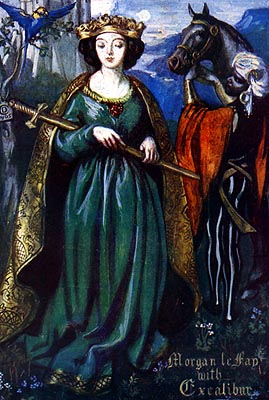Morgan le Fey has been my favourite goddess for nearly 10 years.

In other news – I am old enough to have consistently done something for 10 years.
She’s a funny fish. Although she is sometimes considered an aspect of the Morrighan or of the Welsh Goddess Madron, her primary fame comes from her part in the King Arthur legends. She first pops up in Geoffrey of Monmouth’s Vita Merlini, where she is mentioned as taking King Arthur to the healing land of Avalon as he dies, and she crops up in a number of old French poems and stories as a healer. As time went by, Morgan became more and more of a focal point in the Arthurian legends, eventually becoming the scheming, jealous, vindictive sorceress she is famous for being today.

She’s a goddess mostly born out of a story.
A lot of us consider the evil-ification of Morgan le Fey a consequence of the story’s development in propagandary Christian hands – a good English Christian king and his nice, meek Christian queen up against a strong, sexual, magical, powerful Pagan Woman, who is mean, incestuous and freakin’ crazy. No subtext there, I’m sure. All the old stories and legends seem to do this to their ladies, so I don’t pay it any attention anymore – I look for what is hiding beneath it.
She has loads of links with Avalon (wherever that’s supposed to be), is mentioned often as the leader of the Nine Sisters of Avalon, who together are awesome at everything. She gets linked with Modron too: Modron is the Daughter of the King of Avallach, which roughly translates to the King of the Apple Isle, which, surprise surprise, links back to Avalon as the Isle of Apples.
(Modron – Princess of Apples?)
The “le Fey” bit is a little nod to her faerie nature. I’ve read about a tendency for fierce, strong, badass magical women to be remembered as Faerie Queens – like Medb of Connaght, for example, who became Queen Mab in England – so I reckon she’s gone along those lines. I guess it’s because faeries were dangerous and unpredictable too. Witches were always said to have be on friendly terms with team faerie, so it makes sense for legendary super witches to become faeries.

Anyway, a part of Morgan le Fey’s heritage is that of a faery queen, and that is how I was introduced to her all those years ago, through a book on Faeries by Alicen Geddes-Ward.
What I like about her is that she is a bit scary. She’s not a goddess of light and love and puppies and stuff at all – she’s incredibly practical, and if she feels you need to be thrown in the deep end to sort yourself out, that is what she will do. She’s a Faerie goddess, and we all know the faeries don’t take crap from anyone. She is both a light and dark goddess – like Rhiannon, she can travel through the worlds, a part of all of them but exclusively belonging to none of them. I consider her as the face or personality of the Goddess of Avalon, and because she is the Lady of Avalon, she’s big on transformation and alchemy – changing one thing into another, and wading through the poo to find the gold underneath.
Of course being a faery Queen in Avalon means that she is bound up with death and the otherworlds – they all are, Gwyn ap Nudd, King Sil – which doesn’t mean death in the mournful goth way nesaccerily – in a practical, for new stuff to grow/live old stuff has to die way. She’s a transformation goddess – something always has to be sacrificed for change.
She is the ultimate witch, and I always think of her as the ultimate high priestess as well – incredibly smart, wise, present and patient. My experience of her has always been of a teacher and a guide; she’ll tell you what you need to know, remind you, and if you don’t pay attention she’ll shove it in your face until you deal with it. She reminds me of what is important, what is not, that I have the strength to be who I want to be and to honour my spirituality.

Darling dear, do you worship Morgan or the Morrigan? I’m a follower of the Morrigan. The bitch of a shape shifting Goddess. I’m wondering if perhaps you are worshiping the same Goddess I do. So if you please feel the need to respond to my message here, I’d truly appreciate it. Brightest Blessings. Byrony
One of my favorites =}